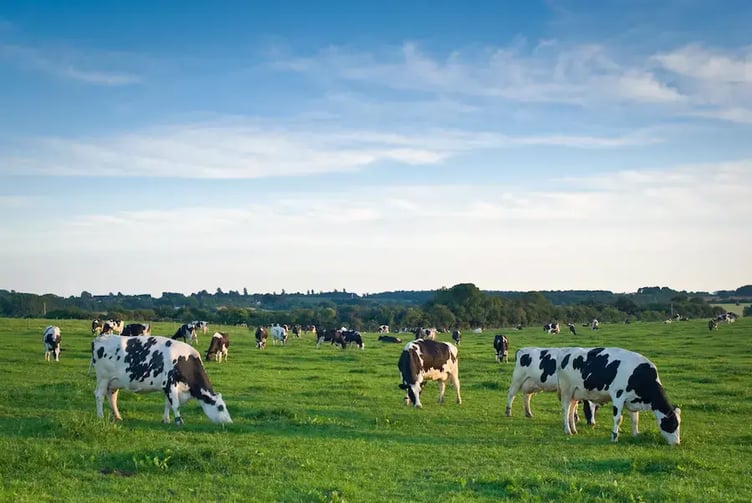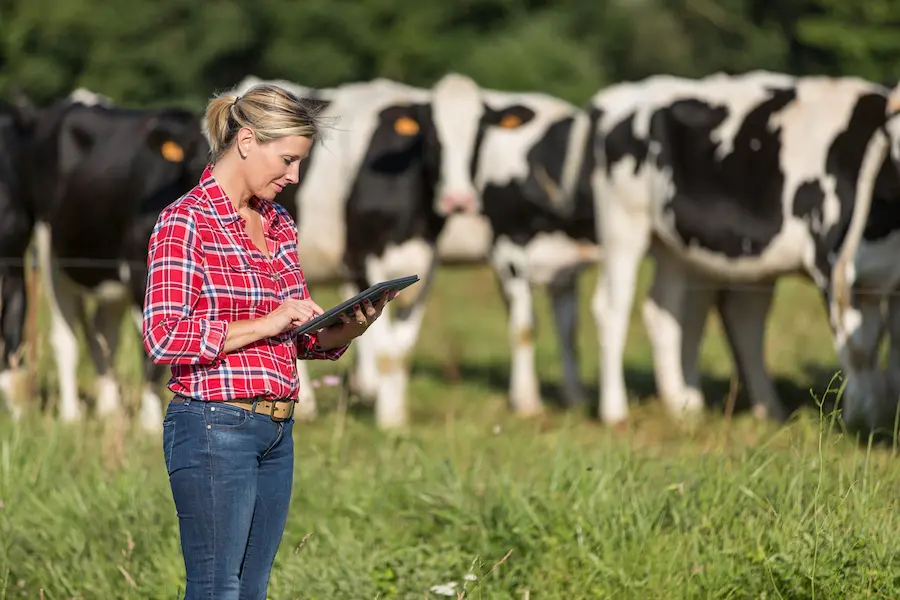Dairy cows and the dairy industry play a vital role in the global economy, providing essential dairy products to millions of people around the world. However, dairy farm success goes far beyond milk production; it also involves an efficient management of human resources. Indeed, Human Resource Management (HRM) plays a critical role in maximizing productivity, creating a positive work culture, and promoting the well-being of both workers and animals.[1]
Prefer to listen to this article? Click the play button below and enjoy our podcast!
Both at the level of dairy cow farms and at the level of the dairy industry, it is increasingly important to have specialized labor. Once employees are in place, employers will need to take necessary steps to ensure employees are productive and engaged.
The reality is that until some time ago, given the scarcity of agricultural workforce, people who were hired did not understand management and other factors essential to the work such as hygiene, food, animal welfare, among others. This is reflected in the quantity and quality of milk and dairy products and of course in the company's success.[2]
In this article, we will explore the significant impact of HRM on the dairy farm success.
Family management vs external labor management
Dairy farms in developed countries have been increasing in size, moving from family tasks to being dependent on external agricultural workforce. For example, in the last four decades in the USA, the number of this type of farm has decreased by 74%, but the number of cows has increased by 325%. It is important to note that such evolution is also associated with technological advances and greater efficiency.[3]
Currently, the majority of dairy farms are structured as a business, with the farm manager no longer just being responsible for the daily tasks of working with their animals but taking on a more important role as a Human Resources Manager.
Strategic recruitment and selection
Recruitment and selection of personnel are crucial steps in building a successful team in the dairy industry. It is essential to select employees with technical skills and knowledge. In addition to technical skills, it is essential to consider the candidate's affinity with animal welfare and willingness to adopt sustainable practices, as commitment can significantly improve operational efficiency.
Human Resources Management is responsible for identifying and attracting the best talent for exploration. This is important because qualified employees are more productive and efficient, which can lead to reduced costs and increased profitability.[4]
Skills development and continuous training
Investing in the development of agricultural workforce skills is essential in the management of human resources on dairy farms. This is important given that the demands of the dairy sector are constantly changing, meaning that employees must always be up to date to perform their duties effectively. Employees must stay informed about legal agricultural practices, technological innovations and industry regulations. Continuous training programs not only train workers, but they also contribute to a dynamic and innovative work environment.[5]
Therefore, it makes perfect sense to talk about ongoing training programs: Training is essential for employees to acquire the skills necessary to perform their duties effectively. Training must be focused on the specific needs of the farm and must be continuous, so that employees are always up to date.[6]
Speaking of training, the health and safety of employees is a priority on dairy farms. Human Resources Management must implement measures to ensure the safety of employees, such as training in occupational safety and hygiene, personal protective equipment and risk management systems.[7]

Human Resources Management is responsible for identifying and attracting the best talent. This is important because qualified employees are more productive and efficient, which can lead to reduced costs and increased profitability.
Efficient communication
Efficient communication is essential to achieving a successful operation and the dairy sector is no exception. Communication must be transparent and open between team members, which avoids misunderstandings and contributes to a work environment where ideas can be shared, thus stimulating innovation and collaborative problem solving.
Conflict management and employee well-being
The well-being of employees is important for their motivation and productivity. Human Resources Management must promote the well-being of employees, through measures such as adequate working conditions and opportunities for personal and professional development. Workers on dairy farms face physical and emotional challenges. This is where Human Resource Management plays a vital role in identifying and resolving conflicts to ensure a healthy work environment. Emotional support programs, guidance and a work environment that values work-life balance are essential components for maintaining a resilient and motivated team.[8]
Performance management and incentives
Regularly evaluating employee performance is essential to identify strengths and areas that require improvement. The implementation of incentive systems, such as bonuses for achieved goals, public recognition and opportunities for career advancement, boost productivity as well as strengthen employee commitment and loyalty.[9]
Sustainability and social responsibility
Human Resource Management also plays a crucial role in promoting sustainability and social responsibility on dairy farms. This requires implementing environmentally sustainable agricultural practices, participating in sustainability certification programs and involvement in community initiatives. It should be noted that employees who identify with sustainable values are more likely to be committed to the long-term success of their companies from the outset.[10]
Conclusion
HRM is an essential tool for the dairy farm success. Effective HRM can help attract, select, develop, motivate and retain the best talent for the farm, which can lead to an improvement in the quality and quantity of milk, production efficiency and company profitability.
References
[1] R. Stup, “Professionalizing human resource management in farms: Why and what this means.” Accessed: Jan. 16, 2024. [Online]. Available: https://www.agproud.com/articles/57255-professionalizing-human-resource-management-in-farms-why-and-what-this-means
[2] B. G. Hansen and A. Greve, “The role of human and social capital in dairy farming,” Rural Society, Sep. 2015, Accessed: Jan. 18, 2024. [Online]. Available: The role of human and social capital in dairy farming
[3] K. E. Mills, D. M. Weary, and M. A. G. von Keyserlingk, “Graduate Student Literature Review: Challenges and opportunities for human resource management on dairy farms,” J Dairy Sci, vol. 104, no. 1, pp. 1192–1202, Jan. 2021, https://www.doi.org/10.3168/jds.2020-18455.
[4] J. Hyde, S. A. Cornelisse, and L. A. Holden, “Human resource management on dairy farms: Does investing in people matter?” Jan. 2011. Accessed: Jan. 17, 2024. [Online]. Available: https://www.researchgate.net/publication/227410439_Human_resource_management_on_dairy_farms_Does_investing_in_people_matter
[5] M. Rovai, H. Carroll, R. Foos, T. Erickson, and A. Garcia, “Dairy Tool Box Talks: A Comprehensive Worker Training in Dairy Farming,” Front Public Health, vol. 4, Jul. 2016, https://www.doi.org/ 10.3389/fpubh.2016.00136
[6] E. D. Al Khawaldeh, “The Impact of Training on Improving Employee Performance: A Case Study on Employees in the Directorate of Education of Ma’an District,” International Journal of Professional Business Review, vol. 8, no. 10, p. e03520, Oct. 2023, https://www.doi.org/10.26668/businessreview/2023.v8i10.3520
[7] J. Ledo, K. A. Hettinga, J. Bijman, J. Kussaga, and P. A. Luning, “A tailored food safety and hygiene training approach for dairy farmers in an emerging dairy chain,” Food Control, vol. 124, p. 107918, Jun. 2021, https://www.doi.org/10.1016/j.foodcont.2021.107918
[8] M. K. Kallioniemi, J. Kaseva, H.-R. Kymäläinen, and J. J. Hakanen, “Well-being at work and Finnish dairy farmers─from job demands and loneliness towards burnout,” Front Psychol, vol. 13, Nov. 2022, https://www.doi.org/10.3389/fpsyg.2022.976456
[9] R. E. Stup, J. Hyde, and L. A. Holden, “Relationships Between Selected Human Resource Management Practices and Dairy Farm Performance,” J Dairy Sci, vol. 89, no. 3, pp. 1116–1120, Mar. 2006, https://www.doi.org/10.3168/JDS.S0022-0302(06)72180-4
[10] A. Amin-Chaudhry, S. Young, and L. Afshari, “Sustainability motivations and challenges in the Australian agribusiness,” J Clean Prod, vol. 361, p. 132229, Aug. 2022, https://www.doi.org/10.1016/j.jclepro.2022.132229
About the author
Ana Vanessa Dias Sousa (Researcher FeedInov CoLAB)
With a degree in Veterinary Sciences from the University of Trás-os-Montes and Alto Douro, she worked for five years as a field veterinarian and in a pig and cattle feed factory. She worked in the pharmaceutical industry as a sales manager and technical support for pigs, cattle, rabbits and poultry in mainland Portugal and the Azores. She is currently at Feedinov Colab as a Researcher in the One Health Department.
Explore author’s articles



Leave your comments here